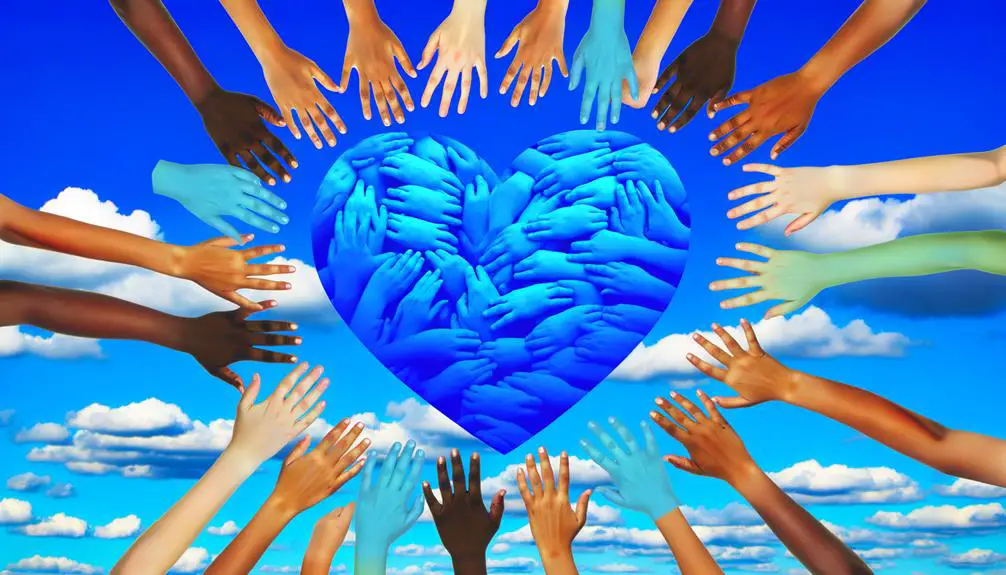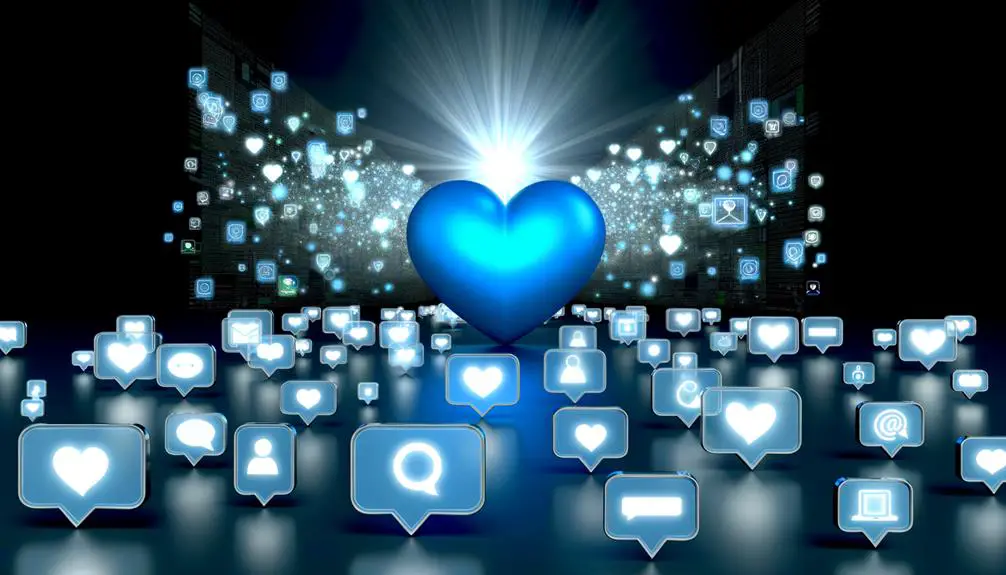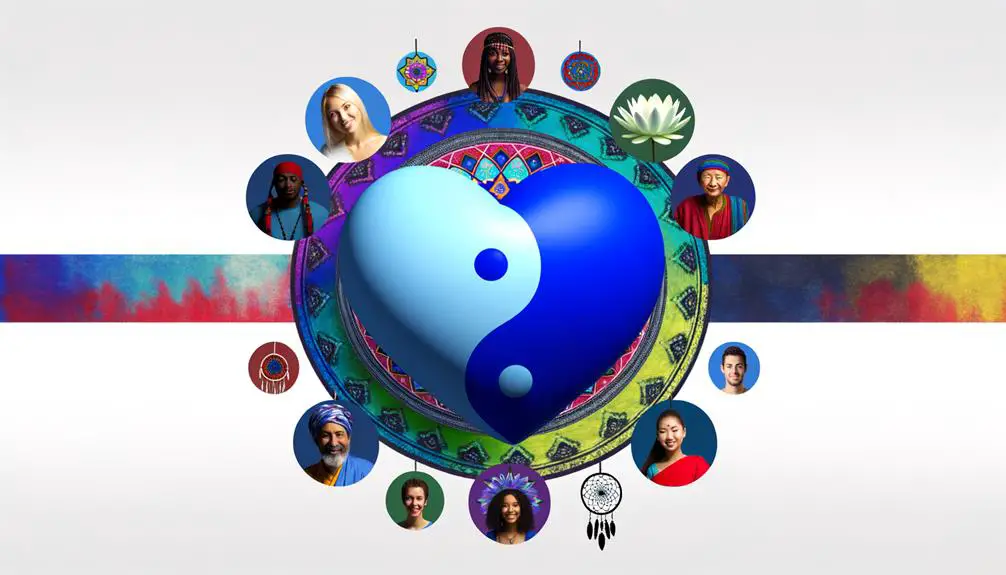What Is the Meaning of the Blue Heart Symbol in Texting?
The blue heart symbol is rich in meaning, encompassing historical legacy and emotional depth. Historically, it evolved from Renaissance art, where blue denoted depth and stability.
In modern times, it is associated with trust, loyalty, and calmness, while also conveying sadness or longing. The symbol signifies deep platonic love and enduring friendships, highlighting reliability and mutual respect.
Its usage in digital communication distinguishes it from romantic connotations, enhancing non-verbal cues of professional camaraderie. Cultural interpretations further enrich its significance, making it a versatile emblem across varying contexts.
To grasp its multifaceted symbolism fully, exploring different dimensions is essential.

Key Takeaways
- The blue heart symbolizes trust, loyalty, and calmness.
- It represents deep platonic love and enduring friendships.
- The blue heart denotes feelings of sadness or longing.
- It is widely used in digital communication for non-romantic affection.
- In various cultures, it signifies tranquility, immortality, and life.
Historical Context

Tracing the historical context of the blue heart symbol reveals its evolution through various cultural, artistic, and social movements. Initially, the heart shape symbolized the human soul, with its color adaptations later emerging to convey nuanced meanings.
In the Renaissance period, blue became associated with depth and stability, often appearing in religious art to signify divine love and protection.
The 20th century saw the blue heart adopted by various social movements, most notably in public health campaigns to represent anti-bullying and mental health awareness. This evolution underscores the symbol's versatility, reflecting societal values and collective emotional states.
Consequently, the blue heart has transcended its original associations, becoming a multifaceted icon with rich historical significance.
Symbolism in Friendships

The blue heart symbol often represents trust and loyalty, fundamental pillars of enduring friendships. Its use signifies a deep platonic love, highlighting the non-romantic yet profound connections that bind individuals.
Understanding this symbolism provides insight into how modern communication encapsulates the essence of friendship through simple, yet meaningful, visual cues.
Trust and Loyalty
In the domain of friendships, the blue heart symbol often signifies a deep-seated trust and unwavering loyalty between individuals. This emblematic use of the blue heart underscores the importance of reliability and steadfastness in interpersonal relationships.
Trust, as a cornerstone of meaningful connections, is visually encapsulated by the blue heart, suggesting that parties involved are dependable and truthful. Loyalty is highlighted, reflecting a commitment to support and stand by each other through various circumstances.
The blue heart serves as an emblem of a relationship where mutual trust is not questioned, and loyalty is a given, fostering a foundation of stability and enduring camaraderie. This symbol eloquently communicates the essence of a bond that is both trustworthy and loyal.
Platonic Love
Within the domain of friendships, the blue heart symbol often embodies the pure and selfless nature of platonic love, highlighting a bond unmarred by romantic intentions. This emblematic representation underscores trust, mutual respect, and emotional support, forming the bedrock of meaningful non-romantic relationships.
The blue heart serves as a visual affirmation of a connection where emotional intimacy flourishes without the complexities of romantic entanglement. It encapsulates the essence of a steadfast alliance, where friends provide unwavering companionship and encouragement.
Additionally, the blue heart's association with serenity and stability enhances its role in symbolizing a balanced and harmonious dynamic. Therefore, the blue heart emerges as a powerful icon, celebrating the enduring and altruistic nature of platonic affection.
Emotional Connotations

Interpreting the emotional connotations of a blue heart symbol reveals a nuanced spectrum of sentiments that range from calmness and trust to melancholy and yearning.
The blue heart often signifies tranquility, reflecting the serene nature of the color blue itself. It frequently embodies trust and loyalty, making it emblematic of reliable, steadfast relationships.
Conversely, the blue heart can also denote feelings of sadness or longing, capturing the emotional complexity of unfulfilled desires or distant affections. This duality reflects the broader psychological impact of the color blue, which is both soothing and introspective.
Therefore, the blue heart symbol serves as a versatile emotive construct, resonating with both positive and contemplative emotional states.
Usage in Digital Communication

In digital communication, the blue heart symbol has gained prominence on social media platforms and in texting, reflecting evolving emoji trends. Its usage often signifies a sense of trust, loyalty, and platonic affection, distinguishing it from more romantic connotations associated with red or pink hearts.
Analyzing its prevalence can provide insights into contemporary social interactions and emotional expression within digital contexts.
Social Media Significance
The blue heart emoji in digital communication often conveys a sense of trust, loyalty, and calmness, providing a nuanced layer of meaning in social media interactions. Its usage is particularly prevalent in platforms like Twitter, Instagram, and Facebook, where it is emblematic of supportive and stable relationships.
The color blue, often associated with tranquility and reliability, enhances the communicative value of this emoji, suggesting emotional depth and sincerity. Social media users deploy the blue heart to signify platonic affection, solidarity, and even professional admiration.
Scholarly analysis indicates that such symbols are instrumental in fostering a sense of community and belonging within digital spaces, reinforcing positive interpersonal connections amidst the fast-paced nature of online communication.
Texting and Emoji Trends
Recent trends in texting and emoji usage reveal an evolving digital lexicon where symbols like the blue heart emoji play a pivotal role in non-verbal communication. This particular emoji has cultivated a nuanced significance, often symbolizing trust, loyalty, and tranquility. Its application extends beyond mere affection, aligning with themes of platonic love and supportive interactions.
The proliferation of emojis in digital communication has transformed how individuals convey complex emotions succinctly and effectively. In professional settings, the blue heart emoji can imply a sense of professional camaraderie or endorsement. As digital communication continues to evolve, the blue heart and other emojis will likely expand their semiotic range, reflecting the dynamic nature of human interaction in the digital age.
Cultural Variations

Different cultures imbue the blue heart symbol with distinct meanings, reflecting diverse traditions, beliefs, and societal values.
In Western cultures, the blue heart often symbolizes trust, loyalty, and tranquility, aligning with the color's general associations.
Contrarily, in certain Eastern traditions, blue signifies immortality and the divine, lending the blue heart an ethereal connotation.
Indigenous cultures might interpret the blue heart through the lens of nature, symbolizing water and the life it sustains.
In digital contexts, globalized communication introduces a blend of these cultural nuances, making the blue heart a versatile symbol.
Its interpretation may vary significantly, influenced by historical, religious, and environmental factors unique to each culture. This cultural specificity enhances the symbol's richness and complexity.
Psychological Impact

Understanding the cultural variations of the blue heart symbol lays a foundation for examining its psychological impact on individuals and communities. The symbol evokes various emotional responses, often associated with tranquility, trust, and loyalty. Studies suggest that the blue heart can foster a sense of calmness and emotional stability. Additionally, its use in digital communication can enhance feelings of connectedness and empathy among users. The table below outlines key psychological impacts:
| Psychological Impact | Description |
|---|---|
| Emotional Stability | Promotes feelings of calm and serenity |
| Trust | Enhances perceptions of reliability and safety |
| Loyalty | Symbolizes steadfastness and dedication |
| Connectedness | Strengthens social bonds and communal ties |
| Empathy | Encourages understanding and emotional support |
These elements collectively contribute to the significant psychological influence of the blue heart symbol.
Practical Applications

The practical applications of the blue heart symbol span various domains, from digital communication to marketing and mental health initiatives.
In digital communication, it is widely used on social media platforms to convey trust, loyalty, and calmness. Marketers leverage this symbol to evoke feelings of reliability and integrity in branding campaigns.
The blue heart has significant utility in mental health awareness, often symbolizing support for individuals affected by mental health issues, promoting empathy and understanding.
Additionally, non-profit organizations utilize the blue heart in fundraising campaigns to signify trust and transparency. Its versatile application across these domains underscores its multifaceted significance, making it a powerful tool for conveying nuanced emotional and psychological messages.
Conclusion
In summation, the blue heart symbol, steeped in history and heavy with meaning, seamlessly signifies sentiments across friendships, evokes emotional echoes, and finds frequent use in digital discourse.
Cultural contexts color its connotations, while psychological perspectives provide profound insights into its impact. Practical applications proliferate, promoting understanding and unity.
This symbol, simultaneously simple and sophisticated, serves as a silent, yet salient, communicator of connection and compassion in contemporary communication.





